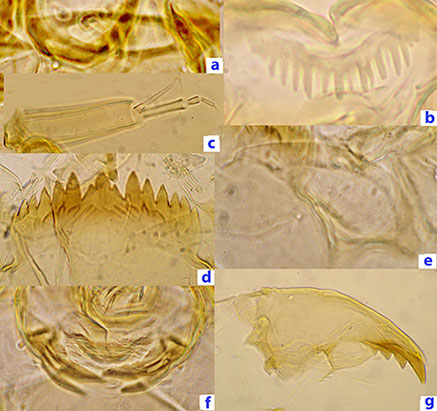Species 4v Chironomus Lobochironomus species 4v
Adult: Not known.
Pupa: Not known.
Fourth instar larva: A small plumosus- or melanotus-type larva, about 8.7 (male)-10.2 (female) mm. Ventral tubules relatively long, posterior pair may be longer (ant. 1.03-1.67 mm; post 1.09-1.1+ mm), Lateral tubules long (400-720 µm). Anal tubules relatively short (about 200 µm) but essentially rounded (width 80 µm) so 2.5 times longer than wide.
Head capsule darkened only around the posterior margin. Oesophageal opening (Fig. a, below)relatively short (50-55 µm) but deeper (12.5-20 µm) so length/width 2.5-4.4.
Mentum (Fig. d, below) about 144-157 µm wide, with 4th laterals barely reduced (type I), central tooth relatively tall with c2 teeth partly distinct (type III or could be type IB). First and second laterals well separated.
Ventromental plates (Fig. e, below) about 150-159 µm wide; 3.11-3.23 times wider than deep and 1.02-1.04 times the mentum width; separated by about 21-27% of width of mentum, with about 39-40 striae; VMR 0.26-0.31.
Pecten epipharyngis (Fig. b, below) with about 17-19 teeth, including small interstitial teeth between some of the normal teeth.
Premandible (Fig. f, below) with relatively broad teeth, coming to a broad point; inner tooth about 3.0-3.3 times wider than the outer tooth.
Antenna (Fig. c, below) with A1 about 3.4-3.6 times longer than wide (about 40% of the VHL), RO between 2/5 and half way up from the base of segment; AR about 1.39-1.42; relative lengths of antennal segments (µm) 101 : 41 : 10 : 14 : 6.5.
Mandible (Fig. g, below) with third inner tooth hardly separated, but somewhat darkened (type IB-C), and with about 12-15 furrows on outer surface at the base; PecM with 10-11 setae; Mdt-Mat 19-20 µm; MTR 0.31.

Mouthparts of C. (Lobochironomus) sp. 4v
a. Oesophageal opening; b. Pecten epipharyngis (some reduced teeth); c. Antenna;
d. Mentum (ty. I); cent. teeth (ty. IB); e. Ventromental plate; f. Premandibles
(with relatively broad points); g. Mandible (Ty. IIB).
Cytology: Unknown.
In thick mud, at depth of about 1m in a bog lake.
Found: Wisconsin - Why Not Bog Lake, County Road N, Vilas Co. (46.01°N, -89.37°W)
The presence of lateral tubules and of smaller interstitial teeth in the PE suggest that this is a species of Lobochironomus. The larger lateral tubules suggest it may be a previously unknown species, but it is possible that this is a polymorphism or an effect of environment. The mentum is similar to that described for C. mendax, but the second antennal segment is relatively longer.
See also L. pseudomendax, L. montuosus, L. dorsalis.
[ Return to Index
| Go to References ]
|
